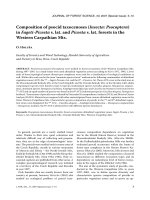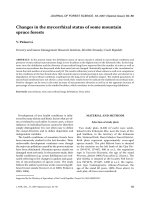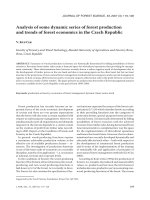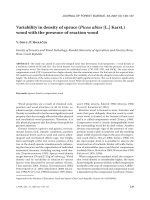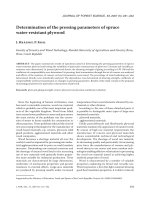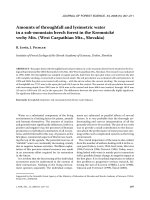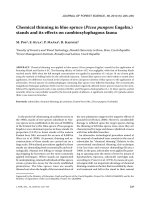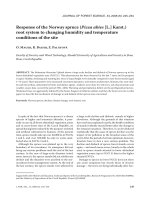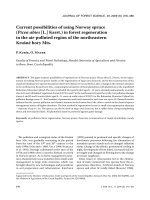Báo cáo lâm nghiệp: "Response of the Norway spruce (Picea abies [L.] Karst.) root system to changing humidity and temperature conditions of the sit" ppt
Bạn đang xem bản rút gọn của tài liệu. Xem và tải ngay bản đầy đủ của tài liệu tại đây (613.36 KB, 10 trang )
J. FOR. SCI., 54, 2008 (6): 245–254 245
JOURNAL OF FOREST SCIENCE, 54, 2008 (6): 245–254
In spite of the fact that Norway spruce is a climax
species of higher and mountain altitudes, it pres-
ently occurs in all forest altitudinal vegetation zones
and in most forest sites of the Czech Republic, its
spread having been induced by the purpose-oriented
and artificial cultivation by humans. At the present
time, spruce stands take up over 40,000 ha in FAVZs
1 and 2, and over 500,000 ha only in water-unaf
-
fected sites in FAVZs 3 and 4.
Although the spruce was planted up to the very
boundary of its ecovalence, its emergence did not
bring any serious problems until the end of the last
century. In the case of large-scale disasters (wind,
snow, insects), the spruce stands did not exhibit any
decline and the disasters were ascribed to the mo-
noculture forest management system. At the end of
the last century, the spruce stands were affected by
a large-scale decline and dieback, namely at higher
elevations. Although the grounds of this situation
have not been explained exactly, the health condition
of stands evidently turned better after the change in
the emission situation. erefore, it can be deduced
realistically that the cause of spruce decline was the
impact of air pollution in the broadest sense of the
word. After the period of certain optimism, however,
foresters have to face a new serious problem. e
decline and dieback of spruce forest stands occurs
again – and much more severe (nearly on the whole
area) in spruce stands situated in lower altitudinal
vegetation zones (up to FAVZ 5) than in the higher
situated FAVZs.
Damage to spruce in lower FAVZs does not show
any acute symptoms but clearly those of chronic
damage – the trees are dying individually after hav-
Supported by the Ministry of Education, Youth and Sports of the Czech Republic, Research Programme No. MSM 6215648902,
and the Ministry of Agriculture of the Czech Republic, Project QG 60060.
Response of the Norway spruce (Picea abies [L.] Karst.)
root system to changing humidity and temperature
conditions of the site
O. M, R. B, E. P
Faculty of Forestry and Wood Technology, Mendel University of Agriculture and Forestry in Brno,
Brno, Czech Republic
ABSTRACT: e Bohemian-Moravian Upland shows a large-scale decline and dieback of Norway spruce up to the
forest altitudinal vegetation zone (FAVZ) 5. is phenomenon has been observed in the last 7 years and its progress
is rapid. Healthy, declining and standing dry trees of equal height were mutually compared in nine forest stands (aged
3–73 years). ese parameters were measured: increment dynamics, root system architecture, biomass, fine root vital-
ity and mycorrhiza, infestation by biotic and abiotic agents. Analyses were done for 414 trees, soil characteristics and
weather course data covered the period 1961–2004. Warming and precipitation deficit are the predisposition factors.
Weakened trees are aggressively infested by the honey fungus (Armillaria mellea), and they die from root rots. In this
paper we describe the mechanism of damage to and dieback of the spruce trees concerned.
Keywords: Norway spruce; decline; climate change; root system; rots
246 J. FOR. SCI., 54, 2008 (6): 245–254
ing exceeded their individual stress limit. A number
of surveys (M 1991; P et al. 1995;
M, P 1999; H, C 2001;
P, M 2004, etc.) indicate that the root
system (changes in architecture, rots, affected func-
tionality of fine roots and mycorrhizal links) is the
tree part which is in general affected first and mostly
without any regard to the stress source.
Work objectives and methods
The authors analyzed causes of the decline of
spruce stands in five selected regions of the Czech
Republic – from FAVZ 2 to FAVZ 5 in nutrient-rich
and acidic sites. With respect to the size of the pa-
per and to the fact that the results from all analyzed
regions are consistent, for further handling in this
paper we decided to study more closely the two fol-
lowing localities situated in the Bohemian-Moravian
Upland where 414 root systems in 62 forest stands
were analyzed:
– Moravec (Forest Administration Forests of the
Czech Republic [LČR] Nové Město na Moravě),
480–520 m a.s.l., forest types 4B1, 4B4, 4H1, air pol-
lution damage zone C, age of analyzed forest stands
13–74 years, Norway spruce outside the optimum of
its ecovalence. Decline has been evident in the last
eight years, the course of dieback is very rapid. e
visual symptom is yellowing of needles which quickly
turn into rusty-brown. At this stage, the needles are
shed. e colour change and the defoliation need not
affect simultaneously all branches of the 1
st
or higher
orders. Namely in older trees, the injury proceeds
from the crown base to the crown top.
– Radiměř (Forest Administration LČR Svitavy),
560–570 m a.s.l., forest types 5K1, 5K2, air pollu-
tion damage zone C, age of analyzed forest stands
3–37 years, Norway spruce at the boundary of its
ecovalence. e decline has been recorded in the
last 2 years. e visual symptom of the injury in all
the analyzed stands is yellowing of needles which
rapidly turn into rusty-brown in older stands. At
this stage the needles are shed. e colour change
and the defoliation do not affect all branches of the
1
st
or higher orders. Namely in older trees the injury
proceeds from the crown base to the crown top and
from the stem to the branch tip. e two analyzed
localities exhibit the following common features:
declining trees are present in all age classes and one
stand includes healthy and injured trees growing side
by side (in Moravec even dead standing trees).
e primary objective of the survey was to com-
pare within one forest stand the emergence and
health condition of the root system and aboveground
part in declining and healthy trees of the same
height with healthy trees as a control. Forest stands
subjected to analyses were monocultures with equal
stocking growing on a plain or on a mild slope (up
to 5%). For partial analyses co-dominant trees from
the stand inside were selected, not injured by game.
In each stand, analyses included 12 healthy trees,
12 injured trees and 12 snags up to an aboveground
part height of 3 m, and always aboveground parts
of minimally 6 trees were also examined to a height
exceeding 3 m. For an easy orientation and a better
review, in the following text, the individual forest
stands are designated by this 3-figure code: the
first figure in the code (letter) expresses the locality
(M – Forest district Moravec, R – Forest district
Radiměř), the second figure in the code (numeral)
expresses the height of the aboveground part of the
analyzed trees, the third figure in the code (letter)
expresses the health condition of the analyzed tree
(Z – healthy, P – injured, S – snag). (Example:
M-23-Z = Forest district Moravec, aboveground part
height 23 cm, healthy tree).
Analyses of root system architecture and health
condition. All roots were manipulated by hand. We
measured up to 36 parameters and characteristics on
each root system while we measured 9 parameters
on aboveground parts. Tables of the results contain
only conclusive parameters. e parameter of Index
p calls for an explanation: it is a calculated parameter
defining the relation between the size of the root
system and size of the aboveground part. It was
calculated as the ratio of the cross-sectional areas
of all horizontal skeletal (HKK) and anchor roots
(anchors) at the place of measurement (in mm
2
) to
the length of the aboveground part of tree in cm. e
greater the Index p value, the larger the root system
of the tree.
Fine roots (< 1 mm) were also analyzed as they
have a decisive significance in nutrient uptake.
ese parameters were analyzed: biomass (weigh-
ing), vitality (vital dyeing), mycorrhizal infection
(quantitatively – using a chemical method and by
measuring the hyphal mantle thickness), type of
mycorrhiza (anatomically after the fungus coloura-
tion in aniline blue).
e trees at the two analyzed localities were con-
sidered in a similar way: controls were trees with de-
foliation (or with colour changes in the assimilatory
tissues) not exceeding 10%, injured were trees with
defoliation (or with the changed colour of assimila-
tory tissues) of 40–60%.
Rooting depth was monitored also in relation to
the individual soil horizons. Roots and stems were
subjected to special analyses the aim of which was
J. FOR. SCI., 54, 2008 (6): 245–254 247
Table 1. Characteristics of aboveground part growth, root system development and health condition – Moravec locality
Stand
designation
Terminal
increment (cm)
Honey fungus
incidence
(% of trees)
Rots
(% of trees)
Max. angle
between
horizontal
skeletal
roots
(degrees)
Deformation
into tangle
(% of trees)
Index p
Whole root system
(with and without rot)
Operating root system
(roots without rot)
2005 2004
roots
stem
base
roots
stem
base
bole
Ip
HKK
Ip
HKK
+ anchors
% share
of anchors
Ip
HKK
Ip HKK
+ anchors
% share
of anchors
M-3-Z 31 41 100 17 100 0 0 55 33 4.4 7.6 38 4.2 7.2 36
M-3-P 55 41 100 100 100 50 0 90 50 3.0 4.4 30 2.4 3.1 23
M-3-S 47 60 100 100 100 100 0 160 100 1.8 2.2 15 – – –
M-5-Z 41 71 50 50 67 0 0 76 67 5.5 6.7 19 5.2 6.5 20
M-5-P 33 67 83 83 100 50 0 111 83 3.8 4.6 3.6 3.7 4
M-5-S does not apply does not apply does not apply does not apply does not apply does not apply
M-7-Z 46 70 100 100 33 17 0 83 33 8.0 10.5 25 8.0 10.3 25
M-7-P 36 60 100 100 100 100 0 92 100 4.2 4.8 11 3.4 3.7 6
M-7-S 34 70 100 100 100 100 0 96 100 5.1 6.2 18 – – –
M-12-Z 34 41 100 100 0 50 0 71 50 12.6 17.5 28 12.6 17.0 28
M-12-P 12 18 100 100 100 100 0 76 100 6.1 9.4 33 6.1 6.8 11
M-12-S 19 20 100 100 100 100 0 77 100 7.2 7.9 8 – – –
M-23-Z 17 21 100 100 100 67 67 50 17 12.7 24.9 48 12.7 23.8 46
M-23-P 16 24 100 100 100 100 100 110 100 13.7 23.3 39 9.2 12.5 24
M-23-S 15 22 100 100 100 100 100 71 100 6.3 11.4 45 – – –
M-25-Z 28 44 100 100 100 50 50 35 0 9.8 20.4 62 9.8 18.9 47
M-25-P 44 52 100 100 100 100 100 70 50 4.9 14.7 52 3.4 6.1 41
M-25-S 29 34 100 100 100 100 50 55 100 6.2 12.3 45 – – –
M-27-Z 29 41 100 100 100 100 67 42 50 17.8 26.5 32 17.8 24.9 28
M-27-P 26 35 100 100 100 100 83 63 50 6.9 11.8 42 3.5 5.5 32
M-27-S 31 38 100 100 100 100 83 72 100 2.9 11.0 73 – – –
248 J. FOR. SCI., 54, 2008 (6): 245–254
to reveal the possible infestation of the former
by parasitic fungi (resin exudation is always
induced by the honey fungus).
Tree damage by biotic and abiotic agents was
assessed visually.
e two analyzed localities were subjected
to chemical soil analyses and for both of them
a record on the “Development of climatic con-
ditions in 1961–2004” was elaborated. Values
of global radiation were taken over from the
Czech Hydrometeorological Institute (ČHMÚ)
station in Znojmo-Kuchařovice, all other meas-
urements were provided by the ČHMÚ station
in Velké Meziříčí (the station is situated at an
altitude of 452 m and at a distance of 13 km
from the analyzed forest stands in Moravec
and 30 km from the analyzed forest stands in
Radiměř). e presented data are the values
aligned to the regression line.
RESULTS
Results of the root system analysis –
Moravec (Tables 1 and 3)
Suppressed terminal increment was observed
neither in the injured trees nor in the trees that
became snags in the same year – this was true of
all analyzed forest stands. Resin exudations on
the roots and on the stem base were observed
in nearly all healthy trees, in all injured trees
and in snags – this was true of all analyzed fo-
rest stands. Rots on roots and stem base were
observed occurring nearly in all healthy trees
and in all injured trees; bole rots were recorded
nearly in all trees over 20 m in height – this
was true of all analyzed forest stands. Injured
trees and snags with aboveground parts not ex-
ceeding 5 m always exhibited much worse root
system patterns than healthy trees. No essential
differences, however, were found with respect to
this parameter in older trees (see the max. angle
between HKK). All the analyzed stands exhibi-
ted an intolerably high occurrence of tangles
– always smallest in healthy trees and showing
a 100% presence in snags. All snags and nearly
all injured trees (with the exception of stand
M-23-P) developed weaker root systems than
the healthy trees; snags have a weaker root sys-
tem than injured trees; both snags and injured
trees exhibit a decreasing number of anchors
in total Ip value (this applies to all stands – see
Whole root system). Injury has a conspicuous
link to root rots (applies to all stands – see
Table 2. Characteristics of aboveground part growth, root system development and health condition – Radiměř locality
Stand
designation
Terminal
increment
(cm)
Honey
fungus
incidence
(% of trees)
Rots
(% of trees)
Max. angle
between
horizontal
skeletal
roots (degrees)
Deformation
into tangle
(% of trees)
Index p
Rooting
depth (cm)
Whole root system
(with and without rot)
Operating root system
(roots without rot)
2005 2004 roots
stem
base
roots
stem
base
bole
Ip
HKK
Ip
HKK
+ anchors
% share
of
anchors
Ip
HKK
Ip
HKK
+ anchors
% share
of
anchors
whole
root
system
operating
root
system
R-1-Z 35 22 33 0 0 0 0 121 100 2.2 2.2 0 2.2 2.2 0 17 17
R-1-P 28 12 50 50 0 0 0 187 100 0.2 0.7 69 0.2 0.7 69 21 21
R-2-Z 61 38 50 50 0 0 0 83 100 6.3 6.6 0 6.3 6.6 0 27 27
R-2-P 60 27 83 17 0 0 0 145 100 1.8 2.2 20 1.8 2.2 20 29 29
R-3-Z 42 48 100 100 100 0 0 73 17 8.1 8.8 8 8.1 8.7 7 48 48
R-3-P 33 36 100 100 100 0 0 165 100 3.3 3.5 5 3.1 3.2 1 25 25
R-5-Z 50 51 100 50 0 0 0 80 50 6.9 7.0 1 6.9 7.0 1 27 27
R-5-P 42 45 100 100 100 0 0 185 100 5.4 5.8 6 3.5 3.6 4 33 18
R-8-Z 87 75 100 67 0 0 0 48 17 10.9 15.9 24 10.9 12.9 9 72 72
R-8-P 82 71 100 100 100 33 17 77 83 9.3 12.7 15 6.7 6.9 4 61 17
J. FOR. SCI., 54, 2008 (6): 245–254 249
Operating root system). Ip value of the whole root
system decreased by 30–60% in all injured trees, in
older trees it was more than in younger trees. Rots
affect anchors more than horizontal skeletal roots
(the Ip value decrease in HKK is smaller in all injured
trees than the Ip value decrease for the whole root
system; decreased was also the share of anchors in
the Ip value for the whole root system). Rots also af-
fected healthy trees; younger trees were observed to
have both HKK and anchors affected by rots, older
trees only the anchors. All injured trees and snags
created the root system with smaller rooting depth
than the healthy trees; snags exhibited a smaller
rooting depth than injured trees. In general, the
rooting depth is given by the tree age – older trees
reach deeper soil horizons with their roots than
younger trees. e disqualification of anchors (due
to rots) considerably affected the original rooting
depth in the injured trees (see Rooting depth of the
operating root system). All injured trees exhibited
an up to 50% decrease in fine root biomass. Younger
injured trees showed an evidently decreased vital-
ity of fine roots while the fine root vitality in older
injured trees showed an increase. Mycorrhizal infec-
tion in younger injured trees was not affected while
older injured trees exhibited an increased mycor-
rhiza infection. e injury had no influence on the
type of mycorrhiza. Operating mycorrhiza is a light
ectomycorrhiza; neither ectendomycorrhiza nor
pseudomycorrhiza was detected. As compared with
healthy trees, however, an about 8% occurrence of
black ectomycorrhiza was recorded.
Results of the root system analysis – Radiměř
(Tables 2 and 3)
Injured trees did not exhibit an essential decrease
in the terminal increment – this was true of all ana-
lyzed stands. All analyzed trees with aboveground
parts higher than 3 m exhibited resin exudations
on roots and all injured trees had them also on the
stem base. Higher than 50% occurrence of resin
exudations on the stem base was found also in all
healthy trees. Nearly all analyzed injured trees with
aboveground parts higher than 3 m exhibited root
rots. Root rots (up to 100%) were also detected in
some healthy trees. Stem base rots and bole rots
were recorded in trees taller than 8 m. No trees were
affected by rots up to the aboveground part height
of 2 m. All analyzed injured trees with aboveground
parts higher than 3 m exhibited an evidently worse
root distribution (see max. angle between HKK)
Table 3. Biomass, vitality, mycorrhizal infection of fine roots and the type of mycorrhiza
Stand designation
Biomass
(%)
Vitality
(%)*
Mycorrhizal infection
(%)
Type of mycorrhiza
M-3-Z 100 100 100 ecto
M-3-P 56 86 96 ecto
M-5-Z 100 100 100 ecto
M-5-P 43 56 96 ecto
M-7-Z 100 100 100 ecto
M-7-P 62 64 149 ecto
M-12-Z 100 110 100 ecto
M-12-P 40 112 121 ecto
M-23-Z 100 100 100 ecto
M-23-P 58 125 134 ecto
M-25-Z 100 100 100 ecto
M-25-P 57 137 122 ecto
R-3-Z 100 100 100 ecto
R-3-P 49 142 140 ecto
R-5-Z 100 100 100 ecto
R-5-P 46 126 130 ecto
R-8-Z 100 100 100 ecto
R-8-P 40 163 174 ecto
*relative expression, in all stand situations 100% of healthy trees
250 J. FOR. SCI., 54, 2008 (6): 245–254
Table 4. Climatic data in 1961–2004 and comparison with normal values in 1961–1990
Period
Characteristics and measured values
mean annual air temperatures (°C) mean air temperatures in IV–IX (°C)
1961–1990 7.2 13.5
1961 6,8 13.1
2004 8.0 14.4
Precipitation sums (mm)
annual in IV–IX
1961–1990 594.3 366.6
1961 605.3 383.1
2004 568.2 337.4
Lang’s coefficient
annual in IV–IX
1961–1990 82.5 27.2
1961 89.2 29.3
2004 71.4 23.5
Absolute occurrence frequency of days with
average daily air temperature +5°C
Annual sums of average daily temperatures
+5°C
1961–1990 213.6 1,702
1961 211 1,625
2004 218 1,900
Potential evapotranspiration
in IV–IX (mm)
Moisture deficit cummulated
in IV–IX (mm)
1961 440.4 28.8
2004 507.6 –46.2
Precipitation abundance (mm/precipitation
day)
Global radiation annual sums
(J/cm
2
)
1961 3.56 390,391 (year 1984)
2004 3.27 431,093
and a nearly 100% occurrence of tangle. Intolerable
root pattern distribution and 100% tangle incidence
were recorded in all analyzed trees (both healthy and
injured ones) with aboveground parts higher than
2 m. All analyzed injured trees developed weaker
root systems than healthy trees; the difference was
getting smaller with increasing tree age. e injured
trees in the analyzed younger stands showed higher
shares of anchors in the Ip value than the healthy
trees; the situation was opposite in the older stands
(see Whole root system). e injury has a linkage to
root rots (see Operating root system). e Ip value
of the whole root system decreased by 10–15% in all
injured trees with root rot, in the older trees more
than in younger ones. Rots affected the anchors
more than horizontal skeletal roots (the decrease in
Ip values in HKK was lower in all injured trees than
the decrease in Ip values for the whole operating root
system; the share of anchors in the Ip value for the
whole operating root system also decreased). Rots
affected healthy trees as well, in most cases only their
anchors. All injured trees with aboveground parts
higher than 3 m created root systems with lesser
rooting depth than healthy trees. Trees with above-
ground parts not higher than 2 m did not show any
essential difference in the rooting depth of the whole
root system (see Rooting depth of the whole root sys-
tem). As the result of disqualification of anchors (due
to their rots) the original rooting depth diminished
in injured trees (see Rooting depth of the operat-
ing root system). All injured trees were observed to
exhibit up to a 60% decrease in the biomass of fine
roots. All injured trees were observed to exhibit up
to a 60% increase in the vitality of fine roots and
up to a 70% increase in the mycorrhizal infection
of fine roots. e injury had no impact on the type
of mycorrhiza. Operating mycorrhiza is at all times
light ectomycorrhiza; neither ectendomycorrhiza
nor pseudomycorrhiza was recorded; injured trees
exhibited a 5% incidence of black ectomycorrhizas.
J. FOR. SCI., 54, 2008 (6): 245–254 251
DISCUSSION
Symptoms of injury, detected tendencies and root
system parameters of both injured and non-injured
trees were nearly identical in the two localities whose
site conditions (altitude and amount of nutrients)
are not very favourable (Radiměř) or they are even
unfavourable (Moravec) for the Norway spruce. is
is in accordance with the condition of stands which
has been less affected until now in Radiměř than in
Moravec.
e basic predisposition factor of tree injury is a
feeble root system; all healthy trees developed larger
root systems than injured trees, snags had even
smaller root systems than injured trees (compared
to the original root system – whole root system with
rots and without them). Differences in the root sys-
tem size resulted from the method of planting (see
Root system deformations into a tangle) and forest
stand tending.
In trees with aboveground parts not exceeding 2 m
and exceptionally also in some older trees, the dif-
ferences in the size of the operating root system are
induced only by the planting method (root system
rots were not detected). Nearly all these trees have
their root systems deformed into tangle – the most
serious deformation; the injured trees have mark-
edly poorer root systems with deformations cor-
responding in their severity to development of the
root system with a lower amount of lower-diameter
root branches.
Although it also holds good that the trees “natu-
rally” developed weaker root systems with increas-
ing degree of injury when their aboveground parts
were higher than 3 m, the root system size was still
impacted by rots on its individual root branches.
e values of the originally developed root system
(whole root system with rots and without rots) began
to differ markedly from those of the operating root
system (root system without rots).
Rots of individual roots affected all injured trees
and a major part of healthy trees (with the injured
trees showing much larger amounts of affected roots
than the healthy trees); dead standing trees exhibited
all or nearly all root pattern branches affected by
rots. Rots on roots, stem base and bole were evoked
by the honey fungus. As indicated by resin exuda-
tions, trees with aboveground parts about 2 m in
height exhibited the presence of the honey fungus
on their roots or stem base; there were, however, no
rots detected. In trees with aboveground parts high
2–8 m, the honey fungus induced – apart from the
resin exudations – also rotting of individual root
branches. In trees with aboveground parts higher
than 8 m, the rot induced by the honey fungus was
detected – apart from resin exudations and rots of
individual roots – also on the stem base and on the
bole itself. (It can be deduced that the impact of the
honey fungus is of a long-term character in the con-
cerned localities, particularly in Moravec.)
e massive spread of the honey fungus in the ana-
lyzed forest stands can be indirectly corroborated by
the occurrence of a great number of trees with swol-
len stem bases, by resin exudations on the bole (e.g.
the percentage of trees with stem resin exudations
in Stand M-25 was visually estimated at 80%) or by
the occurrence of sporocarps (e.g. in the immediate
vicinity of analyzed forest stands in the Radiměř
forest district a 100-year old spruce stand showing
no visual symptoms of injury was felled in winter;
however, at the end of the next growing season all
the stumps exhibited a massive occurrence of honey
fungus fruit bodies).
e honey fungus never infested the entire root
system but rather its individual roots. In trees
with a pronounced anchoring root system, the an-
chors are the first to be infested by rots, later the
horizontal skeletal roots follow (HKK). Trees with
a poorly developed anchoring root system exhibit
simultaneous infestations of horizontal roots as
well. Rots first affected the anchors shooting from
the base or in the immediate vicinity of the stem
base. Both anchors and horizontal roots began to
decompose from their tips. It appears that the tree
injury would have been primarily induced by stem
base rot or by bole rot but clearly by root rots. e
dying trees show no (or just mild) stem base rot or
bole rot, some trees with these rots are still without
any remarkable visual symptoms of injury. at
the root system is not weakened as a whole can be
confirmed by the fact that root system branches un-
affected by rot increase their performance (namely
in older trees which have been adapted more and
created relatively vigorous root systems). Although
the biomass of fine roots is observed to shrink due
to the disability of individual root system branches,
the fine roots exhibit a higher vitality – neither
mycorrhizal infection nor other negative changes
in the mycorrhiza were observed; similarly, no
essential changes have occurred in the vertical
distribution of fine roots up to now. e trees have
concentrated a major part of their energy towards
height growth (diameter increment is retarded in
the injured trees). e statement that root rots rep-
resent a tree-damaging factor can be documented
by the fact that the size of the original root system
of a recently injured tree was undoubtedly sufficient
to assure the successful tree growth.
252 J. FOR. SCI., 54, 2008 (6): 245–254
e analyses were only carried out on trees un-
damaged by game. However, there are also trees
damaged by wildlife occurring in the two localities,
which are subsequently aggressively infested by red
heart rot (Stereum sanguinolenteum). e synergic
action of the two aggressive fungal pathogens accel-
erates the tree decline (25% rot of the girth provokes
an expressive decline also in trees with the Ip value
decreased by 20%).
A scheme of the gradual damage to trees: the
honey fungus infests the root system and gradually
deactivates individual root branches whereas the
operating root system, and also the rooting depth,
are reduced. Responses to the deactivation of indi-
vidual root branches are the increased performance
of healthy roots with energy being concentrated to
height increment – the assimilatory tissues begin to
show symptoms of injury. After breaking “certain
bounds” the remaining operating root system is not
capable to supply nutrition and water any more – the
honey fungus infests with rot very rapidly also the
remaining parts of the operating root system and the
tree dies. e principle of damage is identical in trees
with aboveground parts of about 2 m – the injured
trees have a small operating root system; the size of
the operating root system, however, is not affected
by root rots but rather by root system deformations
(development of a feeble root system).
e question is: what the predisposing factor for
the aggressive attack by the honey fungus is like and
why trees with small operating root systems without
rots die soon after the plantation. Considering the
following facts – the analyzed localities have not
been affected by air-pollution, the supply of soil
nutrients is sufficiently high and acidity of soils is
appropriate, the spruce occurs on the very margin
of its species ecovalence in both localities, the tree
injury has been observed in the several last years and
its progression is rapid, we can hypothesise about
the presence of another stress factor participating
in the tree injury.
It is not only forestry that is influenced by climatic
fluctuations and changes in the concerned locali-
ties. e analyses showed that gradual changes oc-
curring in these localities since 1961 are as follows
(Table 4): annual sums of global radiation in 2005
were by 40,702 J/cm
2
higher in comparison with
1984. is increase approximately represents the
monthly sum of global radiation in April. Mean an-
nual temperatures were gradually growing, and their
final increase in comparison with the year 1961 was
1.2°C, mean air temperatures in April–September
were gradually growing, and their increase was 1.3°C
as compared with the year 1961 (with the highest
temperature increase in July and August). Annual
solar radiation increased by 210 hours in the aligned
series, the onset date of mean air temperatures of
0°C was gradually shifted backwards up to 18 days,
and the ending date was shifted towards by 7 days.
Aligned annual total precipitation amounts are
lower by 37 mm, being strongly affected by tor-
rential rains in recent years, the number of days
without precipitation is considerably increasing
(esp. in May–August) and annual Lang’s coefficient
was rapidly falling (difference of 17.8). Examining
the annual precipitation sums (as compared with
the average values of evapotranspiration for spruce
in FAVZ 4) we can conclude that the precipitation
does not provide enough moisture for the success-
ful growth of Norway spruce stands. e aligned
water balance values for 1984–2004 exhibit a passive
moisture balance for the period I–IX.
From the bioclimatic measurements and from the
response of Norway spruce stands it can be deduced
that a triggering factor for the injury is the change
in climatic conditions (“drought”). e least injured
are trees with large root systems capable of assuring
more water and nutrients than a small root system
can. After the tree weakening by drought the root
system is infested by the honey fungus, rots of in-
dividual roots reduce the root system size and the
“preferred” disqualification of anchors cuts the tree
from groundwater, which further deepens the water
deficit. According to P et al. (1985), the spruce
has a higher foliage biomass as compared e.g. with
the beech or pine, and the difference is ever more
pronounced with the increasing tree diameter. is
may be another reason why the species is consider-
ably endangered by drought.
Although the causes, the symptoms and the
course of injury are identical in the two localities,
it can be assumed (on the basis of the root system
analysis, with the persisting current climatic situ-
ation) that the course of damage should be more
expressive in Moravec (worse site conditions) than
in Radiměř. In both localities the injury will affect
young plantations and young stands whose root
system is weaker than in older stands and reaches
lesser rooting depths. In general, it is necessary to
take in account increased sanitary felling in the al-
ready injured (weakened) older stands.
e analyses indicate that the causes of the decline
are as follows: planting of Norway spruce outside the
optimum of its ecovalence, increased global radia-
tion, weather course change (periods of drought),
weak and malformed root system (induced by
planting biotechnique and forest stand tending) and
planting of non-autochthonous Norway spruce.
J. FOR. SCI., 54, 2008 (6): 245–254 253
A question is to be answered what forestry
measures should be applied with the aim to reduce
(eliminate) the injury. Considering the following
two basic facts that there exist no direct methods
protecting from the honey fungus, only indirect
procedures supporting vigorous tree vitality, for-
esters cannot affect the course of climate, one of
the possibilities is to grow a large root system – by
using the high-quality material for careful planting
(hole planting), submerging the plants, supplying
organic substances to their roots – in such a way
that it is possible to increase the root system size
up to three times. Since the early age, it is neces-
sary to apply radical tending measures in order
to strengthen the root system. After the canopy
enclosure (at a height of min. 4 m), the number
of trees should be reduced to 1,200 ha (after four
years from the intervention, the size of the root
system of released trees would increase by up to
60%). It is, however, a risky procedure since the
survey demonstrated that the honey fungus can
also colonize healthy trees and induce rots of some
of their roots, i.e. that the suggested procedure can
(with the progressing climate change) only mitigate
the damage and the subsequent disintegration of
forest stands.
e changed species composition is the only effec-
tive and long-term solution. Norway spruce is to be
entirely eliminated from regeneration targets up to
FAVZ 3 and it should also be eliminated from regen-
eration targets in nutrient-rich and extreme sites of
FAVZs 4 and 5. In acidic and water-enriched sites of
FAVZs 4 and 5, Norway spruce should be used only
as an admixture up to 30%. Similar conclusions were
obtained by K et al. (2002). In case that it has
been decided to maintain Norway spruce at a higher
proportion (even in lower FAVZs), it is necessary
to switch to planting the spruce ecotype of wooded
hills (only one seed orchard has been established up
to now). It is necessary to minimize the incidence
of solar radiation on the soil in the existing Norway
spruce groups of stands.
CONCLUSION
e Norway spruce decline and dieback in lower
forest altitudinal vegetation zones has become one
of the most serious problems of our forestry. It has
been induced by two factors – planting of spruce on
the very boundaries of its ecovalence and the climate
change (weather course) over the recent years. e
weather course affects the condition of forest stands
in the individual years and in various aspects (with
higher precipitation – a wet year – the symptoms
of injury are less conspicuous, and so is the dam-
age to stands at sheltered aspects). Nevertheless,
the fact that the stands are infested by the honey
fungus at nearly 100% is undisputable – the same
conclusions were also published by J
and C (2002), and, consequently, it is only a
question of time when the parasitic fungus triggers
the tree death (in the last 7 years we have analyzed
among others 2,600 Norway spruce root systems
up to FAVZ 5 before the establishment of young
plantations, 84% of the young trees were infested by
the honey fungus, and losses in Norway spruce after
the planting were higher by 25% than in FAVZ 6). In
this situation, it does not matter to foresters whether
the climate change has been induced by anthropo-
genic activities or by objective factors. If we agree
with the principle of “preliminary caution” – which
should be assigned a high priority in forestry, we can
expect that the current situation will be answered
in correspondence with the essence of the problem.
e climate deviations in the several last years can
induce the total disintegration not only of spruce
stands.
R e f eren c e s
HRUŠKA J., CIENCIALA E. (eds.), 2001. Dlouhodobá acidi-
fikace a nutriční degradace lesních půd – limitující faktor
současného lesnictví. Praha, MŽP ČR: 1–159.
JANKOVSKÝ L., CUDLÍN P., 2002. Dopad klimatických změn
na zdravotní stav smrkových porostů středohor. Lesnická
práce, 81: 106–108.
KANTOR P. et al., 2002. Produkční potenciál a stabilita
smíšených lesních porostů. Brno, MZLU v Brně: 1–86.
MURACH D., 1991. Feinwurzelumsätze auf bodensaueren
Fichtenstandorten. Forstarchiv, 62: 12–17.
MURACH D., PARTH A., 1999. Feinwurzelwachstum von
Fichten beim Dach-Projekt im Solling. AFZ Der Wald, 54:
58–60.
PALÁTOVÁ E., MAUER O., 2004. Reakce jemných kořenů
smrku ztepilého na zvýšené depozice síry, dusíku, působení
sucha a hnojení hořečnatými hnojivy. In: Kořenový systém
– základ stromu. Brno, MZLU v Brně: 49–63.
PERSSON H., FIRCKS Y., MAJDI H., NILSSON L.O., 1995.
Root distribution in Norway spruce (Picea abies /L./ Karst.)
stand subjected to drought and ammonium-sulphate ap-
plication. Plant and Soil, 168–169: 161–165.
PETRÁŠ R., KOŠÚT M., OSZLANYI J., 1985. Listová bio-
masa stromov smreka, borovice a buka. Lesnícky časopis,
31: 121–136.
Received for publication February 15, 2008
Accepted after corrections April 4, 2008
254 J. FOR. SCI., 54, 2008 (6): 245–254
Odezva kořenového systému smrku ztepilého (Picea abies [L.] Karst.)
na měnící se vlhkostní a teplotní podmínky stanoviště
ABSTRAKT: Na Českomoravské vrchovině dochází až do 5. lesního vegetačního stupně k plošnému chřadnutí
a odumírání smrku. Projevuje se v posledních sedmi letech a jeho průběh je rychlý. V devíti porostech (věk 3 až
73 let) byly vzájemně srovnávány stromy zdravé, chřadnoucí a souše. Byla zjišťována: dynamika přírůstu, architek-
tonika kořenového systému, biomasa a životnost jemných kořenů, mykorhiza a napadení biotickými a abiotickými
činiteli. Analyzováno bylo 414 stromů, byly zhodnoceny půdní charakteristiky a průběh počasí v letech 1961 až 2004.
Predispozičními faktory jsou oteplování a nedostatek srážek. Oslabené stromy agresivně napadá václavka (Armilaria
melea), stromy odumírají na hniloby kořenů. V příspěvku je popsán mechanismus poškození a odumírání stromů.
Klíčová slova: smrk ztepilý; chřadnutí; změny klimatu; kořenový systém; hniloby
Corresponding author:
Prof. Ing. O M, DrSc., Mendelova zemědělská a lesnická univerzita v Brně, Lesnická a dřevařská fakulta,
Lesnická 37, 613 00 Brno, Česká republika
tel.: + 420 545 134 136, fax: + 420 545 211 422, e-mail:
